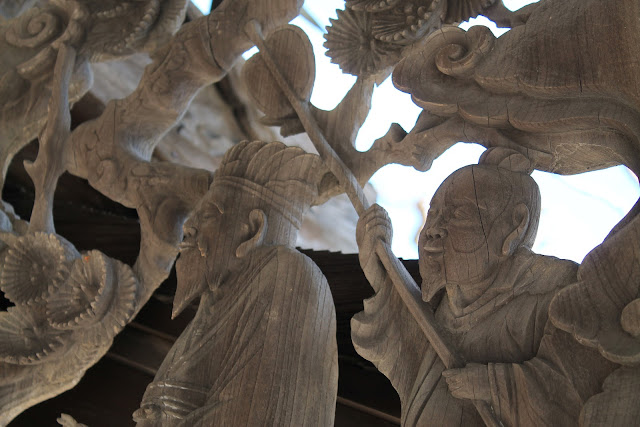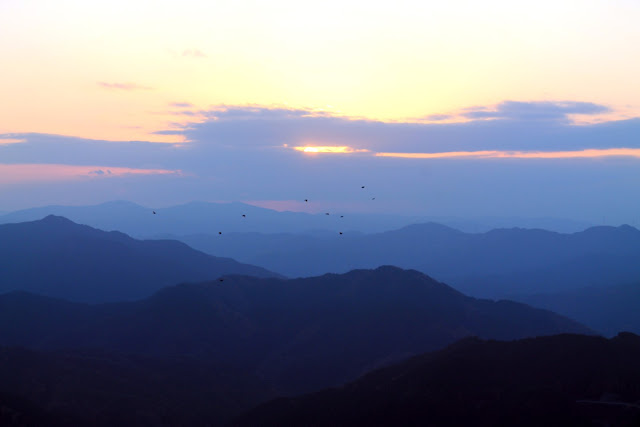The Americans had gone to Tokyo for the long weekend, and my roommates had "baito" (their part-time jobs), so what was I to do but concoct some fabulous adventure that would put everyone else's plans to shame. So that's exactly what I did.
I left my house at 4:55am that Saturday morning, walking like a zombie for the two minutes to the station. But one of the perks to leaving so early was there were definitely empty seats on the train, which was good, because I sat on train after train for three hours (little did I know at the time of the 146 hours yet to come in Russia...). On the train, I began reading Harry Potter in Japanese, and the complexities of trying to comprehend the meaning behind the unknown kanji definitely passed the time. But also the views were amazing. The picture above was through the window of the train car as we entered a valley on the ascent to...
I arrived at 8:00am at the base of the Cable Car station to Koya-san, but decided not to take the Cable Car the rest of the way up the mountain. Instead, I trekked, uphill, along the path of "47 corners," a zig-zagging 1200-year old Buddhist pilgrimage trail up this mountain, a center of spiritual renewal in the Japanese Buddhist tradition. All was quiet except for the occasional rustle of autumn leaves in the slight breeze, or the still more occasional sound of the Cable Car off in the distance, the tracks sounding exactly like the soundbite they use for the horcruxes in the 7th and 8th Harry Potter films, or perhaps I just thought that because I had Harry Potter on my mind.
After the two-hour. relatively strenuous endeavor up the mountain, I arrived in the town of Koya, a place that would continue to dazzle me throughout the day. My first stop, was to the temple site of the women's pilgrimage, or the "Nyonindo". Because women weren't allowed to make pilgrimage in Japanese Buddhism until relatively recently in the grand history of things, devout women would make pilgrimage around the circumference of the town, and this temple is the last remaining of the original seven sights of women pilgrimage around Koya.
I lit a stick of incense, feeling empowered that I would soon be entering what was once a realm of men-only, but also feeling a little guilty that the women whose lives were spent in prayer and meditation on this mountain were not afforded the same opportunity to stroll right into town without so much as a wink of experience practicing the local religion.
But wink I got. Koya is a town of countless Shingon buddhist temples. As I walked through the town, I couldn't help but feel as though the monks outnumbered the non-tourist layman residents, and the temples and monasteries outnumbered the houses and secular buildings.
As I went to the Kongobuji temple complex, the oldest and grandest of those currently in existence, I walked around the age old shoji corridors, glimpsing into ornately decorated tatami rooms, each one decorated with a different theme.
Part of the entrance fee to this particular complex also includes a sembei (traditional japanese cracker) and a cup of green tea, which are served in the main public prayer hall, a long, plain, tatami mat lined room. As I sat sipping my tea, I had the pleasure of observing a real Buddhist service. As it didn't seem too blatantly rude (others were filming), I snatched this soundbite of the service on my ipod, which should give you a taste of the beauties of the service.
After the main temple complex, I went and ate lunch at a local ramen shop. This was my first experience ever eating out alone, but the ladies who served the place were friendly and one of them even sat down with me and chatted for a while once she understood that I could speak more than just the pleasantries needed to get by.
Then I continued on to Okunoin, a temple cemetery of sorts that has become one of the most attractive places to be buried over the centuries, thanks to the grounds' reputation as the place of eternal meditation of Kobo Daishi, the founder of the Shingon Buddhist sect.
The grounds walking up to the main temple were lined with age-old cedar trees and burial tombs and altars of all shapes and sizes. It is a sea of grey and green- grey of the tombstones themselves, and green of all the trees in the background, and the moss that lines the stones.
Many of the people buried here seem to have been forgotten over the ages, for whatever reason. But many of them seem to be visited quite frequently, like this woman, whose make-up remained fresh, and whose sake glasses were filled to the brim as offerings made to her by her descendants or friends.
Among the most amazing places I went on this excursion was unfortunately one I could not photograph. Once you pass Gobyonohashi bridge, you become unable to photograph any of the temple grounds, as you approach the main temple. A monk stood at the entrance to the temple complex blessing passersby by rubbing powdered clove on their hands and forehead. At the back of the temple, there sat dozens of Buddhists praying, as that's the place where Kobo Daishi is supposedly in eternal meditation, having passed from this world. But the most impressive of the sights in this forbidden area is the main temple itself, the Hall of Ten Thousand Lanterns. It is as it sounds, a hall filled to the brim with flickering lanterns, lit eternally. It's really beautiful there, and there, too, I got to experience a Buddhist service, but this time, since it would've been blatantly rude to record, I of course don't have a soundbite to give you this time.
Next, I actually walked half of the Women's Pilgrimage trails. I walked out of the opposite side of Koya from the way I came in, and walked around it's circumference. The panoramic views of the surrounding mountain ranges were absolutely breathtaking and so immediately poignant that I cried upon reaching the first summit. It was really emotionally overwhelming standing there on the edge of the world, seeing the Japan that I hadn't witnessed before in this way, namely the 70% of the country that is undeveloped mountain territory.
As I walked along the Pilgrimage, I finally made it to the Daimon, shown above, the great gate, the official traditional entrance to Koya-san. And the Great Steppe, shown below. These are huge buildings along the trail, that are the welcoming beacons to the town.
Then I continued along the trail to see the beautiful panoramic sunset. From the top of this particular mountain range, you could see the great Steppe to one side, and the untouched mountains to the other.
The trail was lined with Torii, as one of the only Shinto influences on the town, which serve to protect the pilgrims on the trails.
I met up with my first fellow hikers of the day (by virtue of being so far from the city despite Koya's draw as a tourist destination), who snapped this shot of me at the top of the last peak as I waited for sunset.
Watching the sunset over the misty mountains was obviously amazing. But then I was thankful that the Shinto Torii were there to protect me, because it occurred to me just as I was descending the mountain that because I had waited for sunset, I had to trek down the mountain in the dark. It was getting darker by the minute, so I had to tell myself to hurry up (it was only about a kilometer to the lower trailhead), but I also simultaneously had to tell myself to slow down, because if I tripped and fell and broke my leg, I would have been stranded until morning, by which time I would be frostbitten, if not dead, because the temperature was so much colder than coastal Osaka.
But thankfully, I got out of there safely, and rode the cable car down the mountain to the train station, and smoothly rode the rest of the 3 hours back to my nice warm bed at home. Koya-san definitely hits the very top of my list of favorite places in Japan. I'm so glad that I got to go there, and going there alone meant that I had more interesting experiences (eating alone, realizing I would be stranded and die if I couldn't rely on myself, etc.) that ultimately made it not only one of the most rewarding bits of tourism, but also rewarding in personal development, and getting to know myself just a little bit more.





















































